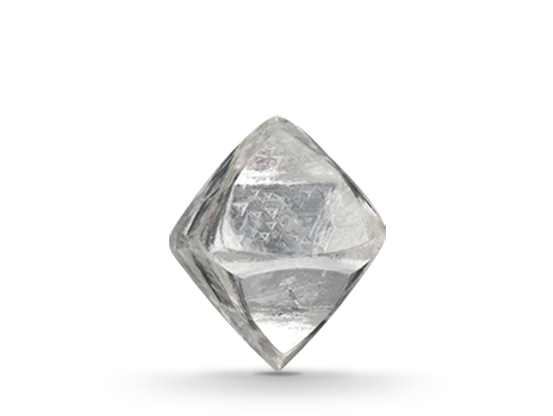OVERVIEW
Diamond forms under high temperature and pressure conditions that exist only about 100 miles beneath the earth’s surface. Diamond’s carbon atoms are bonded in essentially the same way in all directions. Another mineral, graphite, also contains only carbon, but its formation process and crystal structure are very different. Graphite is so soft that you can write with it, while diamond is so hard that you can only scratch it with another diamond.
Diamond’s characteristic chemical composition and crystal structure make it a unique member of the mineral kingdom.
Diamond is the only gem made of a single element: It is typically about 99.95 percent carbon. The other 0.05 percent can include one or more trace elements, which are atoms that aren’t part of the diamond’s essential chemistry. Some trace elements can influence its color or crystal shape.
The way a mineral forms helps determine its identity. Diamond forms under high temperature and pressure conditions that exist only within a specific depth range (about 100 miles) beneath the earth’s surface. Diamond’s crystal structure is isometric, which means the carbon atoms are bonded in essentially the same way in all directions. Another mineral, graphite, also contains only carbon, but its formation process and crystal structure are very different. The result is that graphite is so soft that you can write with it, while diamond is so hard that you can only scratch it with another diamond.
Without any one of these factors, diamond might be just another mineral. Fortunately, though, this special combination of chemical composition, crystal structure, and formation process gives diamonds the qualities that make them extraordinary.
- Mineral: Diamond
- Chemistry: C
- Color: Colorless
- Refractive Index: 2.42
- Birefringence: None
- Specific Gravity: 3.52 (+/-0.01)
- Mohs Hardness: 10
WHERE IS IT FOUND ?
The birthstone for April is now mined around the world. By the early 2000s, South Africa had been joined by other African nations as major producers of rough diamonds. These include the Democratic Republic of the Congo (previously known as Zaire) and Botswana. The former Soviet Union opened its first major mine in 1960, and Russia is now one of the top producers by both volume and value. Diamond mining expanded dramatically with the opening of the Argyle mine in Australia in 1983 and the discovery of several diamond deposits in northern Canada in the 1990s.
Diamond mining in Russia’s eastern Siberia reads like an adventure novel. The setting: tundra, frigid temperatures and short days. The props: jet engines and explosives used to heat and soften the ice covering the kimberlite pipes – vertical, carrot shaped masses of igneous rock that can be a primary source for diamonds. The storyline: In 2013, Alrosa, Russia’s main diamond mining company, estimated that there were 970 million carats still waiting to be found in the frozen tundra.
Diamonds in Botswana lie in the typically hot, semi-arid eastern region of the country. These prolific mines have brought a boom to the economy, creating a growing middle class. The country is also a diamond hub, where approximately 40 percent of the world’s supply of rough diamonds are sorted and valued.
CARE & CLEANING
Diamond (10 on the Mohs hardness scale) is usually durable enough to be placed in an ultrasonic cleaner. However, if your diamond birthstone has many inclusions or has been treated, it it is best to clean it with a lint-free cloth, or use warm water, mild soap, and a soft toothbrush or a commercial jewelry cleaning solution. Also, have your diamond birthstone jewelry periodically cleaned and its setting examined by a professional jeweler to maintain its beauty and integrity over time.
BIRTHSTONE
HISTORY
Diamonds have a long history as beautiful objects of desire. In the first century AD, the Roman naturalist Pliny stated: “Diamond is the most valuable, not only of precious stones, but of all things in this world.”
A diamond has to go through a lot before it reaches the jeweler’s display case. It forms deep in the earth under extreme heat and pressure. It’s ejected violently upward until it arrives at or near the earth’s surface. It’s forced from its hiding place by nature or by man. Then it’s cleaved and cut and polished until its natural beauty shines through.
The world’s love of diamonds had its start in India, where diamonds were gathered from the country’s rivers and streams. Some historians estimate that India was trading in diamonds as early as the fourth century BC. The country’s resources yielded limited quantities for an equally limited market: India’s very wealthy classes. Gradually, though, this changed. Indian diamonds found their way, along with other exotic merchandise, to Western Europe in the caravans that traveled to Venice’s medieval markets. By the 1400s, diamonds were becoming fashionable accessories for Europe’s elite.
In the early 1700s, as India’s diamond supplies began to decline, Brazil emerged as an important source. Diamonds were discovered in the pans of gold miners as they sifted through the gravels of local rivers. Once it reached its full potential, Brazil dominated the diamond market for more than 150 years.
Source of Content : www.gia.edu


